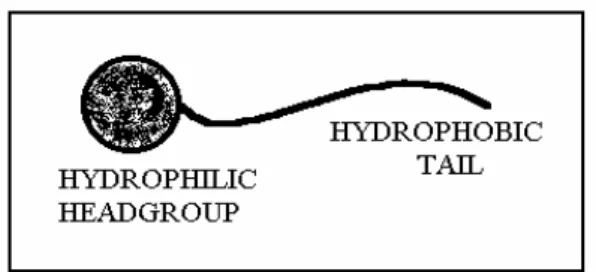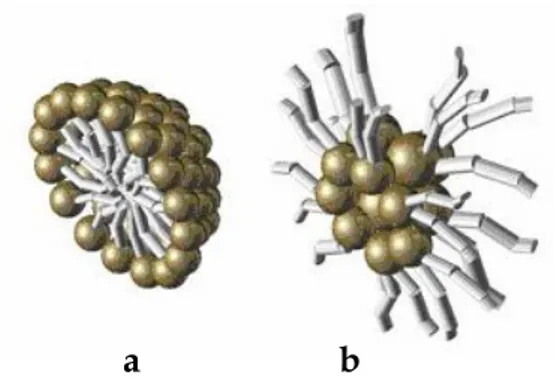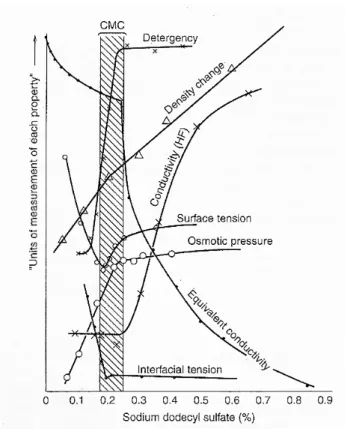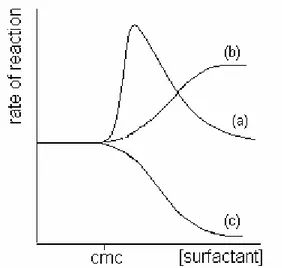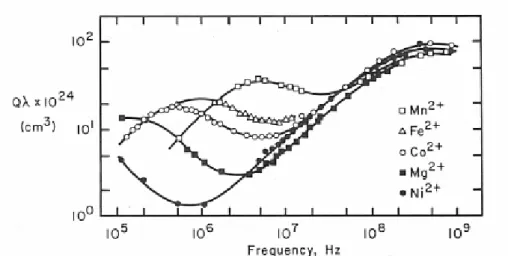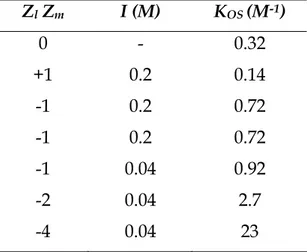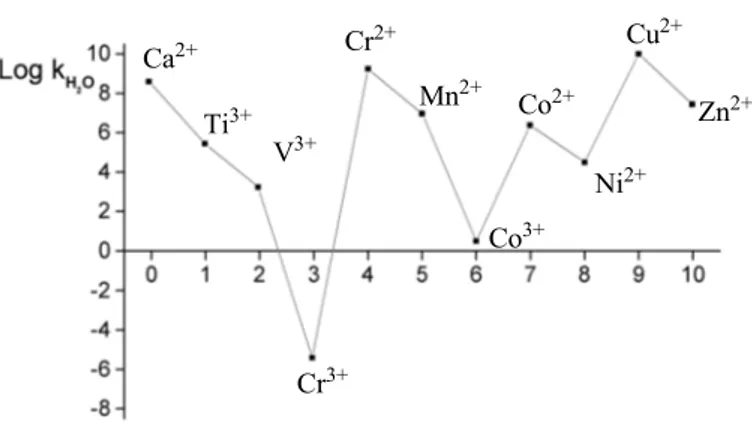CHAPTER 1 Introduction
Metal ions play an essential role in many biological processes and, because of their competition with essential metals in binding with proteins, heavy metal ions act as potent enzyme inhibitors, exerting toxic effects on living organisms. Cadmium, copper, lead, mercury, nickel, and zinc are among the most hazardous heavy metals, and extraction of these pollutants from contaminated sediments and liquid wastes is a task of the highest priority for the protection of the natural environment. On the other hand among the inorganic pollutants there are also precious metals such as gold, platinum, palladium… and other metals of industrial relevance. Therefore, there is continuing interest in developing efficient methods for the selective separation and recovery of metal ions from waste waters, even at very low concentration, so that the water can be recycled and the metals reused. A variety of separation process have been developed for industrial needs such as precipitation, evaporation, ion-exchange resins, reverse osmosis, electrodialysis, and, perhaps the most popular technique, liquid-liquid extraction. In the 90’s, surfactant-based separation processes (J.F Scamehorn et al., 1989; J. Szymanowski and C. Tondre, 1994; C. Tondre, 2000, H.A. Gazzaz and B.H. Robinson, 2000; C. N. Mulligan et al., 2001) have been shown to be a promising alternative in the removal of heavy metals and/or organic contaminants from wastewater streams.
In this thesis we are interested in micellar extraction, in particular of cadmium, palladium and gallium ions. Indeed, along with ionic liquids, micellar aggregates are solvents of the modern era, bringing extraction technology from the macro-environment of bulk organic solvents to the micellar micro-world.
1.1 Surfactants
The term surfactant is derived from SURFace ACTive AgeNT. A surfactant is a substance that reduces the surface tension of the medium in which it is dissolved. By lowering the interfacial tension between two media or interfaces the surfactant plays a key role in the removal and suspension of dirt.
Surfactants may be either of natural or synthetic origin. Surfactants from natural origin (vegetable or animal) are known as oleo-chemicals and are derived from sources such as plant oils or animal fats. They include, for instance, the lipids which are surfactants based on glycerol. Surfactants from synthetic origin are known as petro-chemicals and are derived from petroleum.
A surfactant molecule has a hydrophilic head and a long hydrophobic tail and for this reason it is often regarded as an amphiphilic molecule (Figure 1.1). Many of the physiochemical properties of these molecules in solution stem from this ambivalency. However small changes in the architecture of the surfactants, which alter the balance between hydrophobic and hydrophilic properties, can result in dramatic changes in their behaviour in solution.
Figure 1.1 Structure of a generic surfactant
Surfactants can be categorized, according to the charge present in the hydrophilic portion of the molecule after dissociation in aqueous solution, in four main types:
• anionic • cationic • non-ionic
• amphoteric/zwitterionic
The molecular structure of surfactants means that they have unusual properties, leading to both widespread and highly specialised applications. They can interact with water in a variety of ways, each of which disrupts or modifies the hydrogen
classified, depending on their applications technology, as wetting, foaming, dispersing or deflocculating, emulsifier and detergent agents.
The properties of surfactants fall into two broad categories: adsorption and self-assembly. The adsorption properties mean that surfactant molecules usually locate themselves at the interface between an oil and a water phase or a water and an air phase. This molecular property leads to the macroscopic properties of wetting, foaming, detergency and emulsion formation. Self-assembly is the tendency for surfactant molecules to organise themselves into extended structures in water.
1.1.1 Association of surfactant molecules
Surfactant molecules can associate in aqueous solution to form large aggregates, which, depending on the specific surfactant and solution conditions, can adopt a variety of shapes. This includes the formation of micelles, bilayers, vesicles and liquid crystals (Figure 1.2). This remarkable phenomenon can be rationalized in terms of the tendency of apolar groups to avoid contact with water, while simultaneously the polar parts displays a propensity to be strongly hydrated. The primary tendency for aggregation results from the hydrophobic effect (C. Tanford, 1978). The origin of this effect arises from the fact that hydrocarbon-water interactions are unfavourable compared to the “like-to-like” interactions of both hydrocarbon and water.
Figure 1.2 Forms of surfactant aggregates. a) spherical micelles b) rod like micelle c) vesicle d) bilayer.
Surfactant molecules undergo cooperative association into aggregates of definite size and shape. The hydrophobic effect dictates a lower limit to the size of the aggregate because a minimum number of surfactant monomers has to be united in one aggregate before a sufficiently effective elimination of the hydrocarbon-water interface could be achieved. On the other hand, the existence of an opposing force to the hydrophobic effect, located at the hydrocarbon-water interface, prevents the aggregate from growing into larger assemblies. This repulsive force originate mainly from the electrostatic headgroup repulsions (Patist et al.; 2002). The delicate balance between repulsive and attractive forces, which are coupled to specific regions in the molecule, leads to directional bonding and, therefore, to the formation of aggregates of a definite size and morphology.
It should be noted that surfactant aggregration is not limited to water and it exists in polar nonaqueous solvents too (M. Sjoberg and T. Warnheim; 1997).
1.2 Micelles
A spherical micelle is the simplest surfactant aggregate formed in aqueous solution. Micelles are small aggregates with a size of few nanometers. They are formed in such a way that their hydrophilic head groups are exposed to the water medium and their hydrophobic tails form a water free core. However even after this organisation some of the hydrophobic chain can be exposed to water. Extensive discussions have focused on the conformation of the alkyl chains in the interior (Dill, 1985; Gruen, 1985; Menger, 1985). It has been demonstrated that the alkyl chains of micellised surfactant are not fully extended, as a result, the methyl group of the surfactant molecules can be located near the surface of the micelle, and it has even been suggested that it is able to protrude into the aqueous phase (Clifford, 1965). They are definitely not all gathered in the centre of the micelle as is often suggested in pictorial representations. NMR studies have indicated that the hydrocarbon chains in a micelle are highly mobile, comparable to the mobility of a
Another topic of heated debate is the extent of water penetration into the hydrocarbon interior. Small-angle neutron scattering studies have resolved this matter by indicating that significant water penetration into the micellar core is unlikely (Dill et al., 1984; Tabony, 1984). However, at the interface, extensive contact between water and the hydrocarbon chain segments definitely occurs. The headgroups of the micelle are extensively hydrated. For ionic micelles, a large fraction of the counterions are located in the vicinity of the headgroups. These counterions normally retain their first hydration shell. The part of the surfactant that contains the headgroups and a variable fraction of the counterions is called the Stern region. This region has an important role in solubilisation.
Micelle solutions can solubilise insoluble organic material by incorporating it either at the surface or in the inner core. This properties gives micellar solutions an important role in chemistry in terms of solubilising material, catalysing reactions and extractant as reviewed in the next sections.
Although spherical micelles are the most popular, they can also exist as ellipsoids, discs, elongated rods or lamellar in shape (Figure 1.2), depending on the properties of the solution and on the nature of the monomer surfactant. Israelachvilli et al. (1976) have introduced the concept of “packing parameter”, allowing prediction of the type of aggregate formed by considering the cross-sectional headgroup area and the length and volume of the nonpolar part of the amphiphile molecules. Surfactants containing a single alkyl chain usually form micelles when dissolved in water.
Micelles are also formed in non-polar solvents, where the amphiphiles cluster around small water droplets present in the system, forming an assembly known as a reversed micelle.
The structure of a spherical and a reversed micelle can be schematically represented in Figure (1.3).
Figure 1.3 a) normal micelle b) reversed micelle
The concentration at which micelles start to form is called the critical micelle concentration (CMC). Micellisation is usually driven by an increase in entropy, resulting from the liberation of the water molecules from the hydrophobic hydration shells of the monomeric amphiphile molecules, whereas the enthalpy change is generally close to zero (Lindman and Wennerstroem, 1980).
Micelles are often depicted as static structures of orientated surfactant molecules, however they are very dynamic aggregates. Actually they breakdown and reform rather rapidly. Ultrasonic, stopped-flow, temperature and pressure jump techniques have been employed to study the rate constants associated with the different equilibria involved. In particular these studies showed that there are two relaxation effects involved in the micelle formation process (Lang et al., 1975; Aniansson et al., 1976; Tondre and Zana, 1978). The first, in the order of microseconds, is associated with the exchange of monomers between micelles and the surrounding bulk phase. The second effect, in the milliseconds range, is attributed to the micelle formation and dissolution process.
Due to this dynamic character, the size and shape of micelles are subject to appreciable structural fluctuations. The so-called aggregation number n, represents the number of surfactant monomer in a micelle. Average aggregation numbers are typically in the range of 40 - 100. Spherical micelles have aggregation number of less than 100 while cylindrical or lamellar micelles have aggregation number of several hundreds.
1.2.1Critical micelle concentration
The concentration of surfactant at which micelles first appear in solution is called the critical micelle concentration or CMC. Above the CMC, the concentration of free surfactant is essentially constant, while the micelle concentration increases approximately linearly with total surfactant concentration. The concentration at which micelles first become detectable depends on the sensitivity of the experiments used to determine the CMC. At this concentration, abrupt changes in several physical properties take place. Actually, the CMC can be experimentally determined from the discontinuity or inflection point in the plot of a physical property of the solution as a function of surfactant concentration (Patist, 2001) as shown in Figure 1.4. A wide variety of techniques involving the measurement of physical properties have been used to determine CMC values such as surface tension, electrical conductivity, light scattering, refractive index and viscosity.
Figure 1.4 Changes in some physical properties for an aqueous solution of sodium dodecyl sulphate (SDS) in the neighbourhood of the CMC.
Many factors are known to affect the CMC value in aqueous media. Among these are (Patist, 2001):
• Surfactant structure. As the hydrophobic chain length increases, the CMC decreases. In contrast increasing hydrophilicity of the polar parts will increase the CMC. Moreover the introduction of branching, double bonds or polar functional groups to the alkyl chain leads to a CMC increase.
• Electrolytes. The higher the ionic strength, the lower the CMC. Therefore adding an electrolyte causes a decrease in the CMC; the effect being more pronounced for ionic surfactants.
• Organic additives. The addition of polar organic molecules (like medium chain length alcohols), which are adsorbed mainly in the outer portion of the micelles (at the surface), lowers the CMC. Hydrocarbons solubilising into the inner core of the micelles slightly lower the CMC.
• Temperature. The effect of temperature on the CMC is rather complicated. Anyway it does not influence much the CMC value. For non-ionic surfactants, the CMC decreases with increasing temperature. For ionic surfactants, the CMC decreases to a minimum value and then increases, displaying a U-shaped behaviour .
• Pressure. Generally the lower the pressure, the lower the CMC.
• pH. Where surfactant molecules contain ionisable groups, the degree of the dissociation of the polar group will be very dependent on pH. In general, the CMC will be high at pH values where the group is charged and low when uncharged.
1.2.2 Solubilization
One of the most important characteristics of micelles is their ability to take up all kinds of substances. Actually a number of solutes, which would normally be insoluble or slightly soluble in water, dissolve extensively in surfactant solution above the CMC. Binding of these compounds to micelles is generally driven by hydrophobic and electrostatic interactions.
Solubilisation is usually treated in terms of the pseudophase model, in which the bulk aqueous phase is regarded as one phase and the micellar pseudophase as another. This allows the affinity of the solubilisate for the micelle to be quantified by a partition coefficient, P. Different definitions of P can be found in the literature, differing in their description of the micellar phase; when dealing with catalysis by micellar aggregates it is more convenient to express P as a ratio of concentrations. Solubilization is believed to occur at a number of different sites in the micelle (Rosen, 1989) and the nature of the solubilisate largely determines its position in the aggregate. Saturated hydrocarbons show a preference for the core of the micelle (Reinsborough, 1982). In contrast, solubilisates that contain hydrophilic substituents, such as alcohols or amines, prefer to stay at the surface, where the hydrophilic groups can remain largely hydrated (Porter, 1994). Note that a micelle offers several binding sites for relatively apolar molecules. These include the hydrophobic core and hydrophobic binding sites located in the Stern region. The latter region is particularly flexible in binding molecules as it contains the highly hydrophilic surfactant head groups and hydrophobic domains due to backfolding of the surfactant tails as well as water molecules (Gruen, 1985.) In the case that the solubilisate has an amphiphilic character itself, the apolar parts generally are directed towards the centre of the micelle and its orientation in the aggregate resembles that of the surfactant molecules.
However, since microenvironments available for solubilization change continuously, due to the dynamic nature of micelles, any attempt to situate the solubilized molecule in specific sites of the micelle could be difficult.
1.2.3 Micellar Catalysis
Concerning reactive process, it has been recognized for long time, that the reaction medium plays an important role in controlling the mechanism and rates of chemical reactions. Recently the influence of organized assemblies, such as micelles, has attracted increasing attention. The chemical reactivity exhibited by molecules and ions organized around these assemblies, is often very different from their reactivity in pure water. Actually, chemical reactions can be influenced in
three main ways: by an increase or decrease of rate reaction, by an alteration in the reaction pathway and by an alteration in the reaction stereochemistry.
Most of the research has focused primarily on the kinetics of the reactions involved. In the early 1970’s, the Russian school of Berezin (Berezin et al, 1970; Martinek et al, 1977) attempted to rationalize the effect that micelles had on reaction rates in solution (Figure 1.5). In the presence of ionic surfactants some reaction rates were dramatically enhanced over a narrow concentration range near the CMC to fall off more gradually with increasing surfactant concentration (Figure 1.5, curve (a)). In other reactions, the observed rates rose more gently to plateaus in enzyme-like fashion (Figure 1.5, curve (b)). A further series of reactions displayed the opposite behaviour beyond the CMC, considering that the reaction rates decreased (Figure 1.5, curve (c)). Usually, rate inhibition occurred, as with the enhancement effects, over a narrow surfactant concentration range.
Figure 1.5 Effect of surfactants on reaction rates. Curves (a) and (b) represent micellar
catalysis while curve (c) is a typical example of micellar inhibition.
The phenomenon of the rate enhancement is known as “micellar catalysis”. The fact that the surfactant is not consumed in the reaction and that the surfactant concentration required to bring about marked effects is usually very low, justifies
term “micellar catalysis” is somewhat incorrect (Romsted and Bunton, 1997). The interest in micellar catalysis phenomenon came from many areas. The industry was interested for example in searching for quicker and more efficient routes to synthesizing important organic compounds.
The efficiency of micellar catalysis relies on two principal factors. First, there is the effect of the micellar environment on the rate-controlling step in the reaction mechanism. The relative free energies of the reactant(s) and/or the transition state can be altered when the reaction takes place in the micellar phase instead of the bulk water (Romsted, 1976). However, further studies have shown that this effect is often rather small and cannot account for the very large rate changes in many micellar systems. A more important consideration is the localization of the reacting species in the relatively small volume of the micelles compared to the bulk solution. This leads to a large increase in the effective concentration and the observed rate increases accordingly. An important conclusion is that rate enhancements of bimolecular and higher order reactions are not due to large change in kinetic rate constants but instead are a consequence of the localized concentration of reactants at the micelle-solution interface. The simplest case of micellar catalysis applies to unimolecular reactions where the catalytic effect, according to the above considerations, will depend on the efficiency of binding of the reactant to the micelle and on the differences in the reactivity of the reagent in the bulk aqueous and micellar environments. For more complicated bimolecular or higher-order reactions, the rate of the reaction will be affected also by the local concentration of the reacting species in or at the micelle.
The kinetic data analysis of chemical reactions in micelles generally involves the use of the well-known pseudophase model (Shinoda and Hutchinson, 1962; Menger and Portnoy, 1967), which assumes the micellar solution as consisting of two separate phases. The reaction may take place in both the aqueous and micellar pseudophases and the overall reaction rate is the sum of the rates in each pseudophase. A rate promotion occurs when both reactants are preferentially located in the micelles, while a rate decrease follows if only one of the reactants has been incorporated into the micelles, since in the latter case the two reaction partners are separated.
The pseudo phase model has been applied to a wide variety of reactions (Bunton, 1979), however modifications have been proposed to account for the competitive counterion binding of reactive and inert counterions (Romsted et al, 1991). From an applications standpoint, potential problems with micellar catalysis include the competitive binding between reactive and non reactive counterions, which can greatly reduce the rate of reaction, and the fact that the surfactant must be ionic and opposite in charge compared with water soluble reactants. For instance anionic micelles inhibit the reactions of organic substrates with anions by incorporating the substrate and (at least partially) excluding the anions. On the contrary, cationic micelles incorporate both nonionic and anionic reagents and increase rates of anionic nucleophilic reactions.
1.3 Micellar Extraction
Micellar systems have attracted considerable attention in the last few years as potential extracting media and continue to have a broad appeal for extraction applications. Solutes that bind to micelles in solution are extracted to different extents, depending on the micelle-solute binding interactions. Hydrophobic compounds, are favourably partitioned in the non-polar microenvironment, while metal ions can bind electrostatically to the polar head of the surfactant, or can be extracted by complexation with a ligand soluble into the micellar pseudo-phase, thus being preferentially in form of metallic chelates. The whole process resembles conventional extraction, where the organic phase has been replaced by a micellar pseudo-phase acting as a receiving phase for solutes.
The replacement of the organic phase by pseudo-phases built up with surfactants offers an attractive alternative to classical solvent extraction. Micellar media, indeed, provide a number of potential advantages over water/organic solvent two-phase systems. Firstly, the extraction occurs in a medium which is essentially aqueous so that this system is environmentally acceptable. Secondly, the micelles
Thirdly micelles act as micro-reactors, able to concentrate the reagents and enhance the reaction rate. Finally, extracting agents (or ligands), have often limited solubility in water, but this is considerably enhanced in micellar solutions.
For effective metal recovery, the separation of the micellar pseudo-phase from the aqueous phase has to be achieved. It can be carried out by means of ultrafiltration (Micellar Enhanced Ultrafiltration or Ligand Modified-Micellar Enhanced UltraFiltration).
1.3.1 Micellar-Enhanced Ultrafiltration / Ligand-Modified Micellar-Enhanced Ultrafiltration
A large number of studies have demonstrated that the separation of the micellar pseudo-phase from the aqueous phase can be achieved by ultrafiltration using membranes with pore diameter smaller than the size of the micelle (Scamehorn and Harwell, 1988). Ultrafiltration is a membrane separation process aimed at dissolved or dispersed particles, which have size ranging from 1-100 nm. As a consequence, the pore size is too large to reject small molecules (below 10 3 Da). Micellar Enhanced Ultrafiltration (MEUF) is a surfactant-based separation process in which surfactants are added to a waste stream to promote the removal of small molecules. MEUF has been widely used to remove metal ions (Li et al, 2006; Juang et al., 2003; Scamehorn et al., 1994; Liu and Li, 2005) and organic contaminants (Doulia and Xiarchos, 2007; Zaghbani et al., 2007; Kim et al., 1998; Dunn et al., 1989) from dilute aqueous solution.
Concerning the metals, in which we are mainly interested, the basis of the MEUF technique is the specific binding force between surfactants and metals. Multivalent metal ions have been successfully recovered through MEUF using surfactants having opposite charge. Usually micelles of anionic surfactants (one such typical surfactant is sodium dodecyl sulphate) have been used for the removal of metal ions which will be attracted by the negatively-charged micelle surface. The micellar solution is subsequently passed through an ultrafiltration membrane with pore sizes small enough to retain the micelles and the associated metal ions. As a result, the permeate (which passes through the membrane) will contain very low amounts of unattracted metal and surfactant, while the retentate will have high
concentrations of both metal and surfactant and will be much smaller in volume than the initial solution.
One advantage of MEUF is that organics and heavy metal ions can be removed simultaneously, provided that the micelles have a charge opposite to the target metal ions (Lee et al., 2005; Baek and Yang, 2004; Witek et al., 2006). On the other hand a disadvantage is that there is little selectivity in removing ionic species from solution, except on the basis of charge. Actually Scamehorn et al. (1994) removed divalent cadmium, zinc, copper and calcium ions and their mixtures with an efficiency of at least 96%.
The trapping of metal ions on the micellar pseudo-phase can be achieved also by specific complexation with an amphiphilic ligand bound to the surface or solubilized into the core of the micelle. The extent of the metal ion binding depends on the stability constant of the metal-ligand complex and the use of extractants able to selectively bind the target metal ion, can be very important for selective metal separations. In this case the process is referred to as Ligand Modified-Micellar Enhanced UltraFiltration (MEUF). By using a cationic surfactant in an LM-MEUF process, the micelle will reject the cations which are not specifically bound to the solubilized ligand, into the permeate. The result is that certain target ions can be highly concentrated in the retentate, while ion expulsion causes the noncomplexed metal ions to become concentrated in the permeate. For example Klepac et al. utilized N-n-dodecyliminodiacetic acid in combination with cetylpyridinium chloride (Keplac et al, 1991) for the selective rejection of copper, while Europium(III) was determined in cetyltrimethylammonium bromide micelles by LM-MEUF using a series of extractants derived from 5-pyrazolone (Hebrant et al., 2001).
Theoretical models able to explain and predict the performances of MEUF /LM-MEUF have been proposed (Scamehorn et al., 1994; Dharmawardana et al; 1992). Moreover, a systematic comparison between solvent extraction and MEUF for the removal of copper from aqueous solutions demonstrated that when the volume ratios organic/aqueous or micellar pseudophase/aqueous phase have similar
ligand-modified micellar-enhanced ultrafiltration and by conventional solvent extraction indicates a 17% higher capital and a 43% higher operating cost for the LM-MEUF process compared to the solvent extraction process (Filippi et al., 1998). Since the MEUF techniques has been developed there have been a lot of applications on the removal of cationic metals, such as Cu2+, Co2+, Ni2+, Cd2+…..etc(Akita et al, 1996), some on the removal of anionic pollutants (Fe(CN)63-, CrO42-, NO3-) (Baek et al., 2003) and a few studies have been conducted on the removal of precious metals (Akita et al., 1997). However, not much attention has been given so far to the problem of metal recovery after ultrafiltration. If MEUF or LM-MEUF permit efficient metal concentration, there still exists the problem of subsequent metal recovery from the micellar solution (retentate). Some authors (Reiller et al. 1996) investigated the possibility of metal release by changing ligand and medium conditions (i.e. pH, ligand concentration). Akita et al. (1996) limited themselves to observing that salt addition depresses metal retention and that this characteristic could be useful for the recovery of metal ions from the retentate solution while Liu and Li (2005) employed an electrolysis process to recover copper.
1.4 Mechanism of metal ion complexation
The knowledge of the equilibria and mechanisms of metal complex formation and dissociation reactions can be of great relevance for the optimization of the extraction and recovery of metal ions based on the LM-MEUF. It is therefore useful at this point to summarize the main aspects of the mechanism of metal ion complexation.
The general feature of the mechanism of metal complexes formation in solution have been known since the 60’s, when Eigen and Tamm realized that aqueous solutions of magnesium sulphate absorb ultrasound in an anomalous manner (Eigen and Tamm, 1962). They found out that such behaviour is due to the formation of a complex between Mg2+ and SO42-. Moreover the ultrasound
absorption spectrum indicates the interaction between magnesium and sulphate ions is a two-step process (Figure 1.6).
Figure 1.6 Ultrasound spectrum of MgSO4 in aqueous solution. [MgSO4] = 10-1 ÷ 10-2M.
Subsequent studies on the first series transition metal sulphates (Betchtler et al., 1970) showed that the peak at highest frequency (5×108 Hertz) is metal ion independent, while the peak at lowest frequency changes with metal ions going from 104 Hertz for Ni2+ to 3×106 Hertz for Mn2+ (Figure 1.7).
These results supported the mechanism proposed by Eigen and Tamm (1962) which considers a first stage, diffusion controlled, with the formation of an electrostatic ion pair (outer sphere complex) between the metal and the ligand and a subsequent stage where a water molecule leaves the coordination sphere and is replaced by a ligand one (Scheme 1.1). This second stage is slower and depends on the energy of the metal-ligand bond.
M OH2 OH2 OH2 OH2 H2O H2O + L Kos H2O H2O OH2 OH2 OH2 M L k* H2O H2O OH2 OH2 OH2 M OH2
L
+
H 2 O k -1Scheme 1.1 Eigen and Tamm mechanism
The complexation reaction between a metal ion and a bidentate ligand involves a three-step mechanism. Indeed, after the formation of the outer and inner-sphere complexes (first and second step), the final step is the loss of a second water molecule coupled with ring closure to give a bidentate complex (Scheme 1.2). This mechanism is generally referred to as the Eigen–Wilkins mechanism (Eigen and Wilkins, 1965). Most commonly the rate determining step is the loss of the first water molecule with the formation of the monodentate complex, while ring closure is generally rapid (Wilkins, 1964).
Scheme 1.2 Eigen - Wilkins mechanism
M OH2 OH2 OH2 OH2 H2O H2O + Kos H2O H2O OH2 OH2 OH2 M k1* H2O H2O OH2 OH2 OH2 M OH2 L + H2O k -1 OH2 OH2 H2O L L H2O M L L L L L k2 k -2 +H2O
1.4.1 The “ion pair”
The ion pair concept has been introduced by Bjerrum (1926) to overcome the deficiency of Debye-Huckel theory in explaining the thermodynamic behaviour of high charged ions in solution.
An ion pair indicates a pair of oppositely charged ions held together by coulomb attraction without formation of a covalent bond, which experimentally behaves as one unit. It can be identified as a couple of ions near enough to be able to differentiate their physical-chemical properties from those of independent solvated ions.
The ion pair concentration is related to the free ion concentration by the equilibrium constant KOS (Scheme 1.1), which can be adequately described by the Fuoss equation (Fuoss, 1958):
( ) ( ) a a a U kT a U OS N a e e K + ⋅ ⋅ − = χ χ
π
3 1 3000 4 (1.1)where, U(a) = Zm Zl e02 /aD is the electrostatic energy between M (of charge Zm) and L (of charge Zl), and
( )
1/22 / 1 2 0 I DkT 1000 Ne 8 ⎟ ⎟ ⎠ ⎞ ⎜ ⎜ ⎝ ⎛ π =
χ is the reciprocal of the thickness of
the ionic cloud defined on the basis of Debye-Hückel theory. e0 = electron charge
a = distance of closest approach between ions in the ion pair (around 5 Å) D = dielectric constant of the solvent
k = Boltzmann constant
T = temperature (e02/DkT=7.15×10-8cm, at 25°C) N = Avogadro number
The parameter “a ” is unknown. However, comparison between the KOS values of alkaline earth metals sulphates obtained from ultrasound spectrum and the values calculated with equation 1.1, make it possible to estimate “a ” equal to 5×10-8cm. The Fuoss equation can also be used to calculate c for reactions between ions with the same sign. This can be very useful to evaluate the repulsion between equal charged ions which causes a slowdown in reaction.
Table 1.1 shows the KOS values for the reactive steps studied in this thesis. They have been calculated by equation 1.1 using a = 5×10-8cm and T = 25°C.
Table 1.1 KOSvalues calculated by equation 1.1 using a = 5×10-8cm and T = 25°C.
Zl Zm I (M) KOS (M-1) 0 - 0.32 +1 0.2 0.14 -1 0.2 0.72 -1 0.2 0.72 -1 0.04 0.92 -2 0.04 2.7 -4 0.04 23
1.4.2 The “solvent exchange”
The second stage of Scheme 1.1 clarifies the fundamental role played by the solvent. Indeed, in this stage which is, as we have mentioned, the slowest in the process, the breaking of the M-OH2 bond occurs and therefore this stage must have many characteristics in common with the solvent exchange process in the metal coordination sphere.
Scheme 1.3 represents the substitution of a certain coordinated water molecule, H2O*, with a non-coordinated one. The kinetic constant of this process, kH2O, can be determined by a nuclear magnetic resonance technique (Connick and Fiat, 1963) and its value, strongly dependent on the nature of the cation, indicates its lability.
M
OH2 OH2 OH2 OH2 H2O H2OkH2O H2O H2O OH2 OH2 OH2
M
OH2+
H2O*
+
H2O*Scheme 1.3 The solvent exchange process in the metal ion coordination sphere.
Figure 1.7 shows the variation of the logarithm of kH2O with the number of d electrons in different metal ions (Helm and Merbach, 1999). It can be clearly seen that Cr3+ and Co3+ ions are the most inert, while ions Cr2+ and Cu2+ are the most reactive. Ca2+ Ti3+ V3+ Cr3+ Cr2+ Mn2+ Co3+ Co2+ Ni2+ Cu2+ Zn2+
Figure 1.7 Dependence of the rate constant of the H2O exchange process on the number of d electrons in different cations. (Helm and Merbach, 1999).
It has been experimentally observed that, especially in the complexation of bivalent metal ions the k* value associated to the process of Scheme 1.1 coincides, within reasonable limits, with the kH2O value associated with the reaction in Scheme 1.2.
1.4.3 Activation mechanisms
The first kinetic studies of complexation reactions were carried out with the previously mentioned method based on ultrasound absorption, the use of which is however limited by high cost and difficulty of performance.
Nowadays the most widely used techniques in the study of complexation reactions are stopped-flow, T-jump and P-jump (Bernasconi, 1976).
Their response time is not short enough to allow the measurement of the first of the two stages in Scheme 1.1, therefore the kinetics of the complex formation between a metal ion and a monodentated ligand will be highlighted by a single signal, generally exponential, whose time constant, 1/τ, will depend on the reagent concentrations through the relation:
1 M OS M * OS k C K 1 C k K 1 − + + = τ (1.2)
which is valid in pseudo first order conditions (CM>>CL), i.e. in excess of metal compared to the ligand.
If it is not possible with the above mentioned techniques to evaluate the rate constants of the formation stage of the outer sphere complex formation, it is however possible to estimate its equilibrium constant KOS through equation (1.2). By plotting 1/τ against the metal concentrations, CM, a curve that asymptotically tends to the value (k*+k-1) is obtained. The intercept on the Y axis provides k-1, while the slope of the initial line is equal to k*KOS.
For conditions in which KOSCM<<1, equation (1.2) can be reduced to the simpler form: 1 M * OSk C k K 1 − + = τ (1.3)
In this case the diagrams of 1/τ in function of CM are linear with an intercept of k-1 and a slope of KOSk*, which will be indicated as k.
For systems in which this relation is valid:
k = KOSk* (1.4)
it is not possible to experimentally determine k* separately from KOS. However KOS can still be calculated through equation (1.1) and the value of this constant can be used to determine k* using equation (1.4). This procedure was adopted during the thesis work.
The k* value, determined as explained above, for complexation reactions of a given cation with different ligands is of great help in assigning the complexation mechanism of that cation.
Scheme 1.1 indicates that the formation of the outer sphere ionic pair is a general phenomenon which always occurs whenever two particles of opposite charge are found close enough, and is therefore independent of both the nature of the particles and the mechanism of the next step of interconversion of the outer sphere complex into the correspondent inner sphere complex. The activation mechanisms of this second stage can be classified into dissociative and associative. The occurrence of one or the other activation types depends essentially on the metal. It can however happen that the same metal can shift between a dissociative and an associative activation mechanism by changing the ligand dimensions, but this possibility seldom occurs (Burgess, 1978).
A more careful examination of the kinetic behaviour of metal ions towards complexation reveals that a series of intermediate cases exist between a purely dissociative and a purely associative mechanism, exemplified in Figure 1.8, this shows the transition from the pure dissociative mechanism (D), where the coordination sphere of the metal in the transition state contains only five solvent molecules, to the pure associative mechanism (A), in which the transition state coordination sphere holds as much as seven molecules.
ligand, and also coincides with the rate constant of the solvent exchange process (Scheme 1.2), that is:
k* = kH2O (1.5)
then it can be deduced that the energy of the second stage in Scheme 1.1 is essentially held in the process of weakening of the M-OH2 bond, which takes one of the coordinated H2O groups far from the coordination sphere of the ionic pair before the ligand begins to enter. An empty site thus forms in the coordination sphere, which is then occupied by the ligand.
Figure 1.8 Possible formation mechanisms of a metal complex.
In some rare cases this mechanism bears a completely dissociative character (D). If the H2O molecule has not entirely left the metallic centre as the ligand starts entering the coordination sphere, the activation mode still shows a dissociative character, although at a lesser degree than the D mechanism.
First coordination sphere Entering ligand Outing ligand A Ia I Id D
.
.
.
.
.
.
.
.
This activation mode, much more frequent, is indicated by the initials Id (dissociative interchange) and the relation (1.5) can be applied to it as well.
The activation mode Ia (associative interchange), is characterized by a transition state, more complex than the ionic pair state, in which the ligand is already quite into the metal coordination sphere, while the water has slightly moved out.
Finally, the pure associative state A shows a transition state with six water and one ligand molecule completely inside the metal coordination sphere, but this is pretty rare as well.
The concerted mechanism, I, is very interesting, as the transition state has a volume very similar to that of the reagent state.
Figure 1.8 clearly shows that the volume of the transition state decreases while going from dissociative to associative mechanisms, therefore the measurement of the activation volumes provides an important criterion, in addition to the one stated by the relation (1.5), to correctly assign the reaction mechanism.
